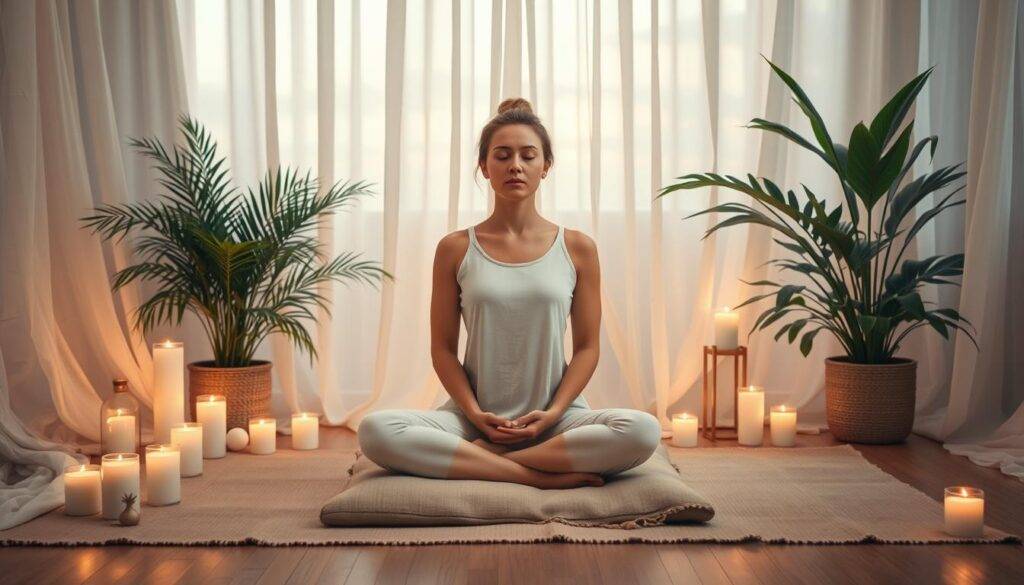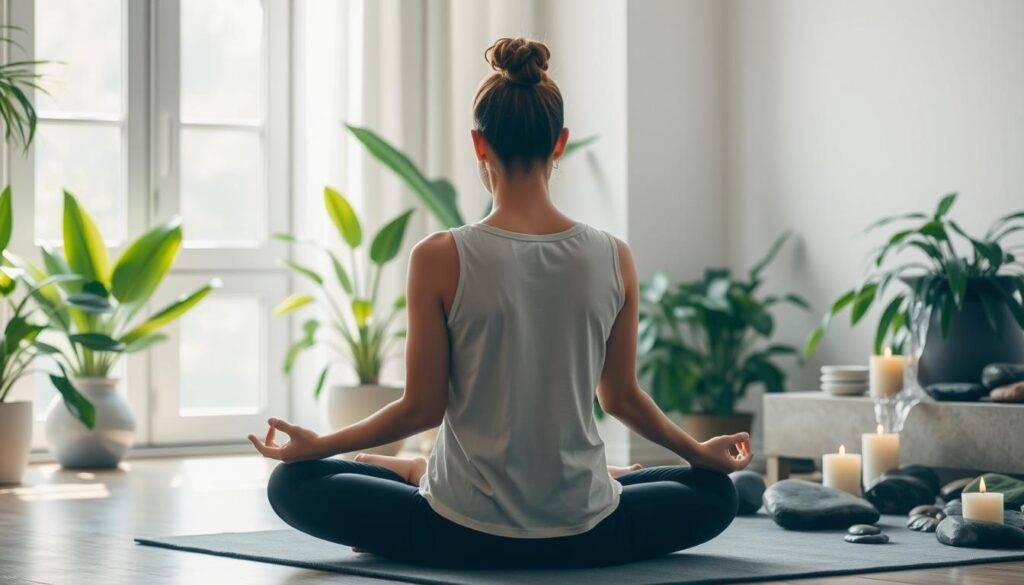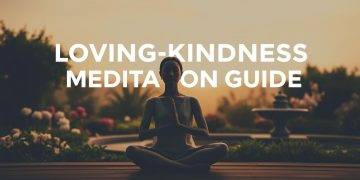“The more regularly and the more deeply you meditate, the sooner you will find yourself acting always from a center of peace.” – J. Donald Walters
In today’s world, staying focused and clear-minded is key for success. Meditation, an ancient practice, helps a lot. It boosts your brain power, lowers stress, and makes you feel better overall.
Meditation teaches your mind to stay present and quiet. It helps you become more aware. Regular meditation can make you more productive, help you make better choices, and bring you peace.
This article will show you different meditation techniques to sharpen your mind. You’ll learn about Focused Attention Meditation (FAM) and other methods. Discover how meditation can change your life.
Key Takeaways:
- Meditation is a powerful tool for improving mental clarity, focus, and cognitive function.
- Regular meditation practice can reduce stress, enhance decision-making abilities, and boost productivity.
- Focused Attention Meditation (FAM) is particularly effective for improving concentration and mental focus.
- Meditation can have a positive impact on sleep quality, emotional well-being, and physical health.
- Incorporating mindfulness and breath awareness into daily activities can further enhance the benefits of meditation.
Understanding the Foundations of Focused Meditation
In today’s fast-paced world, focusing and staying mentally clear is key. Focused attention meditation (FAM) is a powerful tool to help you do just that.
What is Focused Attention Meditation (FAM)?
FAM means focusing on one thing, like your breath or a mantra. It helps calm your mind and reduce distractions. By practicing, you can improve your focus and mental clarity.
The Science Behind Mental Clarity
Studies show that FAM changes brain activity. It boosts areas for attention, emotions, and memory. Regular FAM practice can also improve focus and concentration.
Key Benefits for Brain Function
Focused attention meditation offers more than just better focus. It also:
- Boosts problem-solving skills
- Helps manage stress and emotions
- Increases creativity and flexibility
By quieting the mind and improving concentration, FAM enhances your mental clarity and brain function.
The Physical and Mental Benefits of Regular Meditation Practice
Meditation can greatly improve your life. It helps reduce stress and boosts memory and mental clarity. Let’s look at how it can make you feel better overall.
Meditation is great for reducing stress. It can help with conditions like irritable bowel syndrome, PTSD, and fibromyalgia. It calms your mind and body, easing the effects of chronic stress.
It also improves memory and mental clarity. Regular meditation can help you stay focused and fight memory loss. It makes your mind sharper and more agile.
Meditation is good for your heart health too. It can lower blood pressure, easing the heart’s workload. This might even prevent heart disease.
Meditation also boosts mental health. It can reduce anxiety, depression, and obsessive behaviors. It’s a natural way to tackle mental health issues.
Lastly, meditation helps with managing chronic pain. It can change how you feel pain and emotions. This makes it easier to live with chronic pain.
“Meditation is not about becoming a different person, a new person, or even a better person. It’s about training in awareness and developing the power of concentration.”
Meditation can change your life for the better. It can reduce stress, improve your mind, and enhance your overall well-being. Start meditating to unlock your mind and body’s full potential.
Essential Components of Effective Meditation Practice
Meditation is more than just sitting and breathing. It’s about creating the right space, sitting correctly, and managing your time well. These three elements are crucial for a transformative practice.
Creating the Right Environment
The place where you meditate greatly affects your experience. Look for a quiet spot with no distractions. A calm, comfortable space helps you focus and find inner peace.
Proper Posture and Body Positioning
Your sitting or standing position is very important. Keep your spine straight, shoulders relaxed, and head balanced. This proper posture aids in deep breathing and mental clarity.
Time Management for Meditation Sessions
Being consistent is key in meditation. Begin with short sessions and gradually increase the time. Choose a specific time each day for your meditation. This helps build discipline and makes meditation a lasting habit.
Focus on the environment, posture, and time management for a better meditation experience. These elements are the foundation for a focused and transformative practice. Embrace them to unlock your practice’s full potential.
| Meditation Environment | Proper Posture | Time Management |
|---|---|---|
| Quiet, peaceful location | Straight, upright spine | Consistent daily practice |
| Free from distractions | Relaxed shoulders | Start with short sessions |
| Comfortable and calming | Balanced head positioning | Gradually increase duration |
“Meditation is not about getting anywhere else, but about being where you are and experiencing it fully.” – Jon Kabat-Zinn
Meditation Techniques to Improve Mental Clarity and Focus
Meditation can greatly improve your mental clarity and focus. There are many techniques to try, each with its own benefits. You can choose from focused attention, breath awareness, visualization, and mantra recitation. Each method helps in different ways to boost your mental health and focus.
Focused attention meditation is a powerful technique. It involves focusing on one thing, like your breath or a mantra. This helps your mind stay present and reduces distractions, leading to better focus and clarity.
Breath awareness meditation is another effective method. It involves paying attention to your breath. This practice helps you stay in the moment and feel calm, improving your focus and mental performance.
Visualization exercises are also beneficial. They involve creating vivid mental images. Through visualization meditation, you can improve your focus and tap into your creativity.
Mantra meditation is great for quieting the mind. It involves repeating a word or phrase. This rhythmic repetition helps you achieve deep focus and calm.
It’s important to try different meditation techniques to find what works best for you. By making meditation a part of your daily routine, you can unlock your mind’s full potential. This leads to better mental clarity and focus.
“Meditation is not about becoming a different person, a new person, or even a better person. It is about training in awareness and getting a healthy sense of perspective. You’re not trying to improve or change yourself, you’re simply trying to be yourself.” – Jon Kabat-Zinn
Breath Awareness: The Gateway to Mindfulness
Breath awareness is a key meditation technique. It helps you focus, lowers stress, and boosts mental clarity. By paying attention to your breath, you can anchor your mind.
Different Breathing Techniques
Trying out various breathing techniques can make your breath awareness practice stronger. Here are some effective methods:
- Diaphragmatic breathing: Also known as “belly breathing,” this technique involves inhaling deeply through the nose, allowing your belly to expand, and exhaling through the mouth, letting your belly relax.
- Alternate nostril breathing: This technique involves closing off one nostril at a time, alternating between the left and right sides as you inhale and exhale.
- Counted breaths: Slowly counting your inhalations and exhalations can help you stay present and focused.
Monitoring Breath Patterns
Watching your breath’s natural rhythm and patterns can anchor your attention. It helps you become more aware. By noticing changes in your breathing, you can understand your emotions and physical state better. This knowledge can improve your well-being.
Incorporating Breath Work into Daily Life
Adding breath awareness to your daily routine can greatly improve your mental clarity and focus. Take mindful breaths during breaks, while waiting, or during tasks. This simple act can reduce stress, enhance concentration, and increase your sense of presence.
“Mindfulness is about being fully awake in our lives. It is about perceiving the exquisite vividness of each moment. We also gain immediate access to our own powerful inner resources for insight, transformation, and healing.”
– Jon Kabat-Zinn, Founder of Mindfulness-Based Stress Reduction (MBSR)
By making breath awareness a part of your daily life, you open the door to mindfulness. This leads to better mental clarity, focus, and overall well-being.
Focused Attention Meditation for Beginners
If you’re new to meditation, focused attention meditation (FAM) is a great starting point. It’s simple yet powerful, helping you clear your mind and improve focus. By learning to focus, you’ll enjoy the many benefits of regular meditation.
FAM is easy to follow. Just pick something to focus on, like your breath or a sound. Sit comfortably and keep your attention on it. If your mind drifts, gently bring it back.
- Begin with short sessions, 5-10 minutes, as a beginner.
- As you get better, increase the time you meditate.
- Stay patient and keep practicing. It gets easier with time.
Regular FAM practice will boost your mental clarity and focus. It helps you stay present, ignore distractions, and dive into tasks fully.
| Meditation Technique | Description |
|---|---|
| Zen Meditation | An ancient Buddhist tradition that involves sitting upright and focusing on the breath, aiming to foster a sense of presence and alertness. |
| Mantra Meditation | A technique where practitioners focus on a repeated mantra (a syllable, word, or phrase) to quiet the mind and achieve a deeper state of meditation. |
| Transcendental Meditation | Taught by Maharishi Foundation instructors, it involves sitting comfortably with eyes closed for 20 minutes twice a day to engage in effortless practice. |
| Kundalini Yoga | Aims to strengthen the nervous system to better cope with stress, emphasizing the importance of savasana or relaxation pose to integrate neuromuscular changes. |
Consistency is key with focused attention meditation. Make it a daily habit, and you’ll see the benefits of beginner meditation and concentration practices.

Advanced Visualization Techniques for Enhanced Focus
Unlock the power of your mind with advanced visualization techniques. These methods can boost your focus and mental clarity. By using mental imagery, you can engage your brain deeply, leading to greater productivity and clarity.
Creating Mental Images
The key to good visualization is creating vivid mental images. Start by focusing on a specific object or scene. Use all your senses to make it real in your mind. Imagine the textures, colors, and shapes with great detail.
As you get better, try making more complex mental scenes. Combine different elements into a rich experience.
Using Objects for Concentration
Physical objects can help you concentrate during visualization. Choose something meaningful to you, like a crystal or a piece of art. Study its details well.
Then, use this object as a focus point in your visualization. It will help you stay focused and deepen your concentration.
Progressive Visualization Exercises
- Start with simple scenes, like a calm nature spot or a peaceful room.
- Make your mental images more complex by adding more details and textures.
- Try to picture busy scenes or detailed landscapes.
- Visualize abstract things, like emotions or math problems, to improve your thinking.
Regular practice of these techniques can greatly improve your focus and mental clarity. It makes your brain work deeply, enhancing your awareness and concentration. This helps you reach your goals more easily and clearly.
“Visualization is the most powerful mind tool we have for creating our future.” – Dr. Emmett Miller, renowned mind-body medicine pioneer
Mantra Meditation: Using Sound for Mental Clarity
Mantra meditation is a powerful way to find mental clarity and focus. It uses sound to help you concentrate better. By repeating a special word or sound, you can feel more positive and calm.
Mantras help you stay focused and relaxed. They can be simple, like “breathing out, I am stress-free.” This makes it easier for beginners to start.
“After engaging in 20 minutes of mantra meditation every morning, the patient experienced significant improvements in therapy engagement and overall mental health within a few weeks, exhibiting a remarkable transformation within nine months.”
Mantra meditation does more than just clear your mind. It can also lower stress and improve your health. It’s good for your heart and brain.
- A systematic review and meta-analysis found that mantra meditation significantly reduces stress levels and enhances mental health.
- Studies on patients with memory loss revealed that mantra meditation can improve visuospatial memory, connectivity, and verbal memory performance.
- Mantra meditation has been observed to lower blood pressure and reduce risk factors for cardiovascular diseases.
Adding sound meditation to your day can change your life. It brings focus, peace, and clarity. Pick a mantra that feels right to you and practice it regularly. You’ll see the amazing effects it can have.

Open Monitoring Meditation Practices
Open Monitoring Meditation (OMM) boosts your mental clarity and focus. It’s different from focused attention meditation because you observe thoughts and feelings without judgment. This way, you become more flexible and adaptable, making daily life easier.
Observing Thoughts Without Judgment
The heart of OMM is non-judgmental observation. You learn to watch your thoughts without getting caught up in them. It’s not about ignoring thoughts; it’s about seeing them come and go without attaching to them.
Developing Mental Awareness
Practicing OMM regularly improves your mental awareness. As you get better at watching your thoughts, you notice patterns and connections. This awareness helps with emotional control, better decision-making, and creativity.
Research shows OMM enhances divergent thinking, which is coming up with many new ideas. By being open and non-judgmental, you can tap into your creativity and find new solutions.
“Meditation is not just about sitting in silence; it’s about cultivating a state of non-judgmental awareness that can transform our lives in profound ways.”
Adding OMM to your self-care routine can change your life. It lets you see life with a more flexible and insightful mindset. By watching your thoughts without judgment and increasing your mental awareness, you open doors to personal growth, problem-solving, and emotional well-being.
Integrating Mindfulness into Daily Activities
Mindfulness is about being fully present and aware. It boosts mental clarity and focus. Adding mindfulness to your daily life can make these benefits even stronger. It helps you live more mindfully.
Mindful eating is a simple way to start. Enjoy each bite, noticing flavors, textures, and sounds. This makes meals more fun and connects you with your food.
- Try mindful walking. Notice your feet touching the ground, sights, and sounds. Let your body guide you.
- Make routine tasks like brushing teeth or washing dishes mindful. Focus on the sensations and movements.
Adding mindfulness to your day trains your brain to stay focused. It extends the good from your mindfulness exercises and daily meditation. This mindful living way improves your well-being, bringing calm, clarity, and connection.
“Mindfulness is not something you have to find time for. It’s something you make time for, because it makes your life richer, fuller, and more meaningful.”

Start small and be consistent to integrate mindfulness. Even a few minutes a day can improve your focus and clarity. Welcome mindfulness into your daily life.
Overcoming Common Meditation Challenges
Starting a meditation journey can be very rewarding. But, it comes with its own set of challenges. These obstacles can test your determination. But, with the right mindset and strategies, you can overcome them.
Dealing with Wandering Thoughts
One big challenge is the constant chatter in your mind. It’s normal for thoughts to wander. But, learning to gently bring your focus back is crucial.
When your mind drifts, just acknowledge the thought. Then, return your focus to your breath or the present moment.
Managing Time Constraints
Finding time to meditate in our busy world can be tough. Start with just 5-10 minutes a day. As you get more consistent, you can increase the time.
Make a dedicated space for meditation. Fit it into your daily routine, whether it’s morning or evening. Sticking to a schedule is important.
Building Consistency
Keeping up a regular meditation practice can be hard. Life’s demands and distractions can get in the way. To overcome this, set achievable goals and track your progress.
Celebrate every small victory. Having friends or joining a meditation group can help you stay motivated and accountable.
Remember, facing challenges is part of the meditation journey. Be patient, kind to yourself, and open to change. By pushing through, you’ll find mental clarity, focus, and resilience.
“The true meditation is not the exercise of something particular, but the realization of what one already is.” – Nisargadatta Maharaj
Measuring Progress in Your Meditation Journey
Starting your meditation journey is exciting. But, remember, progress is often slow and not always easy to see. It’s more about the journey than reaching a goal. Focus on the small, yet big, changes happening inside you.
Keeping a meditation journal is a great way to track your meditation progress. Writing down your thoughts, feelings, and insights helps you see how you’ve grown. It shows how your mindfulness and self-awareness are improving.
Look for changes in your life, like better focus, less stress, and more calm. Notice how you handle daily challenges, like patience and emotional control. These small changes show your practice is working.
“Meditation gets easier over time, similar to building muscle strength through exercise, with regular practice resulting in increased proficiency.”
Remember, meditation’s benefits grow slowly. Be patient and kind to yourself. Don’t compare yourself to others or set high goals. Just enjoy the journey and celebrate each small victory.
Regular practice is essential for meditation’s full benefits. By making mindfulness a part of your daily life, you’ll see more and more benefits. Trust in your growth and enjoy the deep changes in your meditation journey.
Creating a Sustainable Meditation Routine
Building a regular meditation routine is key for clear thinking and focus. By dedicating a time each day for meditation practice, you can make it a lasting habit. This habit brings many benefits.
Morning vs. Evening Practice
The time of day for meditation goals matters a lot. Morning meditation can start your day positively, helping you tackle tasks with clarity. Evening meditation, however, can help you relax, reduce stress, and sleep better.
What’s best for you depends on your lifestyle and what you like. Try both morning and evening to see what fits your rhythm.
Setting Realistic Goals
- Begin with easy goals, like meditating for 5 minutes a day.
- Slowly increase your meditation time as you get more comfortable.
- Change your routine if it doesn’t fit your life anymore.
- Enjoy small wins and be kind to yourself as you build your routine.
Consistency is the secret to a good meditation practice. By setting reachable meditation goals and finding a rhythm, you can make meditation a lasting part of your life. This will improve your mental clarity and focus for years.
“Meditation is not about becoming a different person, a new person, or even a better person. It is about training in awareness and development of some capacities of the mind.” – Jon Kabat-Zinn
Using Technology and Apps for Guided Meditation
In today’s world, technology is a big help for meditation. Apps like Headspace, Calm, and Insight Timer offer guided meditations. They match your needs and goals, making meditation easier and more consistent.
Headspace, for example, has a lot for beginners and experts. It starts with the Basics program, teaching meditation in 10-minute sessions. For those who want more, there are meditations for stress, sleep, and more. Headspace also tracks your progress and lets you meditate offline.
Technology is great for improving focus and mental clarity. But, it’s also important to meditate on your own. This lets you find your own way and grow your inner awareness. Using apps and practicing on your own can make your meditation journey even more powerful.
FAQ
What is Focused Attention Meditation (FAM)?
Focused Attention Meditation (FAM) means focusing on one thing, like a sound or feeling. It helps quiet your mind and improve focus. Studies show it changes brain activity, making you better at paying attention and handling emotions.
What are the key benefits of regular meditation practice?
Regular meditation is good for your body and mind. It lowers stress, boosts memory and mental clarity, and increases focus. It also improves willpower, sleep, and pain management. Plus, it can lower blood pressure, anxiety, and depression, and increase kindness.
What are some essential components of effective meditation practice?
Good meditation needs a calm place, the right posture, and time. Find a quiet spot, sit straight with relaxed shoulders, and start with short sessions. Then, slowly increase the time as you get better.
What are some different meditation techniques to improve mental clarity and focus?
There are many ways to improve focus and clarity, like focused attention, breath awareness, and visualization. Try different methods to find what works best for you.
How can breath awareness meditation improve mental clarity?
Breath awareness is key for mindfulness. Techniques like deep breathing or counted breaths help keep your focus. Adding breath work to your day can improve focus and reduce stress.
How can beginners start with focused attention meditation?
Beginners can start with simple focused attention. Pick something to focus on, like your breath, and set a short time. Sit comfortably and keep your focus on it. If your mind wanders, gently bring it back. Practice often, increasing time as you get more comfortable.
What are some advanced visualization techniques to enhance focus?
Advanced visualization can really boost focus. Create vivid mental images and use objects to help concentrate. Try progressive visualization to improve your imagination and focus.
How can mantra meditation promote mental clarity?
Mantra meditation uses sound to focus the mind. Choose a word or sound that feels right to you. Repeat it during meditation to improve concentration and reduce distractions.
What is the purpose of Open Monitoring Meditation (OMM)?
Open Monitoring Meditation (OMM) is about watching thoughts and feelings without judgment. It improves awareness and creative thinking. OMM helps you observe your mind without getting caught up in it.
How can I integrate mindfulness into my daily activities?
Mindfulness in daily life boosts focus and clarity. Try being fully present while eating, walking, or doing chores. These exercises help keep your mind sharp and focused.
How can I overcome common meditation challenges?
Common challenges include wandering thoughts and finding time. To deal with wandering thoughts, gently refocus. Start with short sessions and gradually increase time. Make a regular practice schedule and have a dedicated space.
How can I measure progress in my meditation practice?
Track progress by noticing changes in focus, stress, and overall well-being. Keep a journal to record your experiences. Look for improvements in daily life, like patience or better emotional control. Remember, progress is often small and not always linear.
How can I create a sustainable meditation routine?
For a lasting routine, pick a consistent time and set achievable goals. Morning meditation can set a positive tone, while evening sessions can help you relax. Start small and adjust as needed to fit your lifestyle.
How can technology and apps support my guided meditation practice?
Technology and apps can help with guided meditation. They offer structured programs, timers, and tracking. They’re great for beginners but balance them with your own practice to grow.




























































